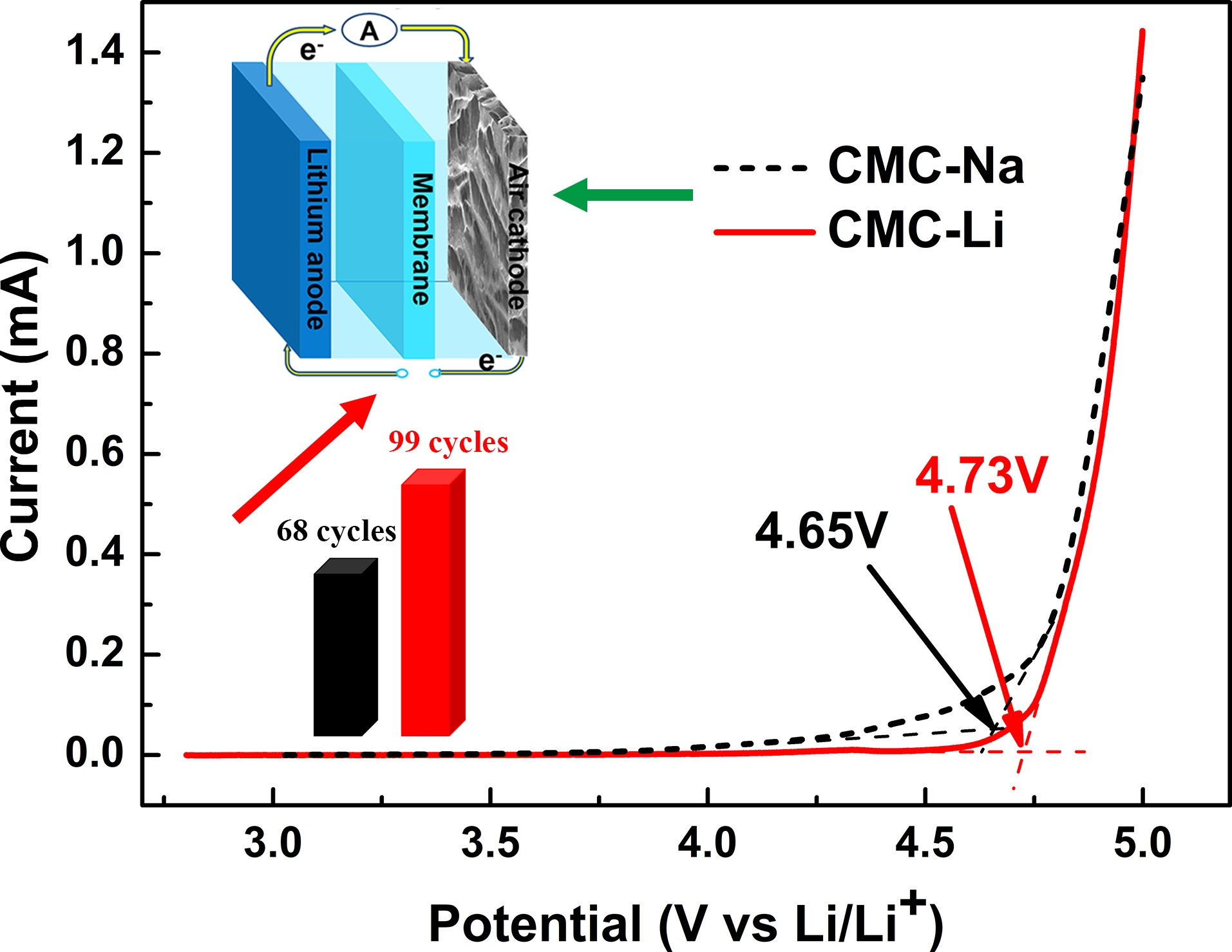

Lithium-ion modified cellulose as a water-soluble binder for Li-O2 battery
Received date: 05 Jan 2021
Accepted date: 03 Mar 2021
Published date: 15 Jun 2022
Copyright
An environment-friendly, water-soluble, and cellulose based binder (lithium carboxymethyl cellulose, CMC-Li) was successfully synthesized by using Li+ to replace Na+ in the commercial sodium carboxymethyl cellulose (CMC-Na). Li-O2 batteries based on the CMC-Li binder present enhanced discharge specific capacities (11151 mA·h/g at 100 mA/g) and a superior cycling stability (100 cycles at 200 mA/g) compared with those based on the CMC-Na binder. The enhanced performance may originate from the electrochemical stability of the CMC-Li binder and the ion-conductive nature of CMC-Li, which promotes the diffusion of Li+ in the cathode and consequently retards the increase of charge transfer resistance of the cathode during cycling. The results show that the water-soluble CMC-Li binder can be a green substitute for poly(vinylidene fluoride) (PVDF) binder based on organic solvent in the lithium oxygen batteries (LOBs).

Key words: cellulose; binder; specific capacity; cyclabi- lity; lithium-oxygen batteries
Chenyi HU , Aiming WU , Fengjuan ZHU , Liuxuan LUO , Fan YANG , Guofeng XIA , Guanghua WEI , Shuiyun SHEN , Junliang ZHANG . Lithium-ion modified cellulose as a water-soluble binder for Li-O2 battery[J]. Frontiers in Energy, 2022 , 16(3) : 502 -508 . DOI: 10.1007/s11708-021-0750-3
| 1 |
Luntz A C, McCloskey B D. Nonaqueous Li-air batteries: a status report. Chemical Reviews, 2014, 114(23): 11721–11750
|
| 2 |
Feng N, He P, Zhou H. Critical challenges in rechargeable aprotic Li-O2 batteries. Advanced Energy Materials, 2016, 6(9): 1502303
|
| 3 |
Girishkumar G, McCloskey B, Luntz A C,
|
| 4 |
Ottakam Thotiyl M M, Freunberger S A, Peng Z,
|
| 5 |
Jian Z, Liu P, Li F,
|
| 6 |
Zhu Q C, Xu S M, Harris M M,
|
| 7 |
Lu J, Cheng L, Lau K C,
|
| 8 |
Xu J J, Wang Z L, Xu D,
|
| 9 |
Lin Y, Moitoso B, Martinez-Martinez C,
|
| 10 |
Tan G, Chong L, Amine R,
|
| 11 |
Freunberger S A, Chen Y, Peng Z,
|
| 12 |
Kwabi D G, Tułodziecki M, Pour N,
|
| 13 |
Adams B D, Black R, Williams Z,
|
| 14 |
Kwabi D G, Batcho T P, Amanchukwu C V,
|
| 15 |
Liu Q C, Xu J J, Yuan S,
|
| 16 |
Shui J L, Okasinski J S, Kenesei P,
|
| 17 |
Johnson L, Li C, Liu Z,
|
| 18 |
Ganapathy S, Adams B D, Stenou G,
|
| 19 |
Lu J, Lee Y J, Luo X,
|
| 20 |
Yao X, Dong Q, Cheng Q,
|
| 21 |
Qiao Y, Wu S, Yi J,
|
| 22 |
Zhang Z, Bao J, He C,
|
| 23 |
Xiao J, Mei D, Li X,
|
| 24 |
Bian Z, Tang Z, Xie J,
|
| 25 |
Yang S, Ren W, Chen J. Li4SiO4-coated LiNi0.5Mn1.5O4 as the high performance cathode materials for lithium-ion batteries. Frontiers in Energy, 2017, 11(3): 374–382
|
| 26 |
Li W, Tang W, Qiu M,
|
| 27 |
Papp J K, Forster J D, Burke C M,
|
| 28 |
Key B, Bhattacharyya R, Morcrette M,
|
| 29 |
Kovalenko I, Zdyrko B, Magasinski A,
|
| 30 |
Wang Z, Dupré N, Gaillot A C,
|
| 31 |
Komaba S, Yabuuchi N, Ozeki T,
|
| 32 |
Guerfi A, Kaneko M, Petitclerc M,
|
| 33 |
Shen S, Wu A, Xia G,
|
| 34 |
Courtel F M, Niketic S, Duguay D,
|
| 35 |
Horstmann B, Gallant B, Mitchell R,
|
| 36 |
Xie L, Zhao L, Wan J,
|
| 37 |
Lau S, Archer L A. Nucleation and growth of lithium peroxide in the Li-O2 battery. Nano Letters, 2015, 15(9): 5995–6002
|
| 38 |
Qiu L, Shao Z, Wang W,
|
| 39 |
Chen H, Ling M, Hencz L,
|
| 40 |
Ling H Y, Wang C, Su Z,
|
/
| 〈 |
|
〉 |